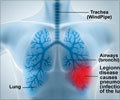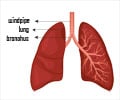Intermountain Medical Center researchers have developed the first real-time electronic screening tool to identify patients with pneumonia.

The new tool works seamlessly with the hospital's computerized medical screening and diagnosis technology that physicians are already using at Intermountain Healthcare. It monitors patient data, extracts relevant clinical features, calculates patient pneumonia probability and then alerts caregivers when patients are likely to have pneumonia.
A study of the development and initial test of the new electronic tool is published in Monday's (March 18) issue of the Journal of the American Medical Association Internal Medicine.
The development of this tool is important because diagnosing pneumonia can be problematic for emergency room physicians due to the many factors – nearly 40 – involved in making a diagnosis.
"Our goal is to have the tool standardize what we do to ensure that we are all doing the same things consistently for all patients," says Caroline Vines, MD, an emergency medicine physician at Intermountain Medical Center and co-investigator. "The best thing about the tool is that it's easy to use and reminds you to order the appropriate tests and proper antibiotics for the patient."
The electronic tool was developed by a multi-disciplinary team for use in the emergency departments at four Intermountain Healthcare hospitals in the Salt Lake Valley: Intermountain Medical Center, LDS Hospital, Alta View Hospital, and Riverton Hospital. These are the busiest emergency departments in the state of Utah.
"The tool provides a way of more quickly and accurately identifying pneumonia patients in the emergency department, which alerts doctors to use the second part of the tool that provides guidance for treatment," said Nathan Dean, MD, section chief of pulmonary and critical care medicine at Intermountain Medical Center, professor of medicine at the University of Utah School of Medicine and lead author of the study.
The tool analyzes over 40 variables, including vital signs, lab results, chest x-ray reports, nurse examination findings, and the patient's primary symptom, to determine the probability of a patient having pneumonia. The data is calculated and then displayed on computer screens in the emergency department. If it measures a 40 percent or greater likelihood that a patient has pneumonia, the physician is alerted and the patient data reviewed to determine whether the patient indeed has the infection.
"Aspects of pneumonia care are fairly sophisticated, and this helps us gather the data needed to support a more accurate and timely diagnosis," said Dr. Dean. "The tool exceeds human ability to process information."
Doctors have been using the screening tool since May 2011 at the four emergency departments. Although the tool is now being used, it will undergo further development to improve performance. It also is being evaluated to learn how it impacts physician treatment protocols and patient recovery.
"We're studying if the tool helps physicians and we'll have future results on how it impacts physician workflow and clinical outcomes," Dr. Dean said.
"We hope that the decision support tool helps physicians make more consistent decisions about who should be admitted to the hospital versus being treated as an outpatient, and who requires admission to the ICU. Ultimately, we hope the tool helps reduce the number of deaths caused by pneumonia."
Source-Eurekalert
 MEDINDIA
MEDINDIA



 Email
Email










